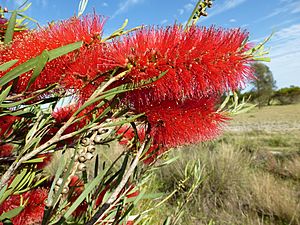Lesser bottlebrush facts for kids
Quick facts for kids Lesser bottlebrush |
|
|---|---|
 |
|
| Melaleuca phoenicea leaves, flowers and fruit | |
| Scientific classification | |
| Genus: |
Melaleuca
|
| Species: |
phoenicea
|
| Synonyms | |
|
Callistemon phoeniceus Lindl. |
|
The Lesser Bottlebrush, also known as Scarlet Bottlebrush or Melaleuca phoenicea, is a beautiful plant. It belongs to the myrtle family, called Myrtaceae. This plant is special because it grows naturally only in the south-west part of Western Australia. The local Noongar people have their own name for it: Tubada. It's a type of shrub with thick, blue-green leaves. In spring and summer, it produces bright scarlet flowers that look like bottlebrushes.
Contents
What Does the Lesser Bottlebrush Look Like?
The Lesser Bottlebrush is usually a large shrub. It can also grow into a small tree, reaching up to 6 metres (about 20 feet) tall. Its leaves are arranged one after another along the stem. They are quite long, from 31 to 114 millimetres (about 1.2 to 4.5 inches). The leaves are also narrow, about 3 to 10 millimetres (0.1 to 0.4 inches) wide.
The leaves are thick and have a pretty bluish-green colour. You can see a main vein in the middle. They also have tiny, hidden oil glands.
Flowers and Fruit of the Bottlebrush
The flowers are a stunning bright red or deep scarlet colour. They grow in spikes at the ends of branches. These branches keep growing even after the flowers bloom. You can also find flower spikes on the sides of the branches.
Each flower spike is about 50 to 65 millimetres (2 to 2.5 inches) across. There are usually 15 to 55 individual flowers in each spike. The petals are small, about 2.9 to 7.3 millimetres (0.1 to 0.3 inches) long. They fall off as the flower gets older. Each flower has many stamens, which are the parts that produce pollen.
The Lesser Bottlebrush usually flowers from October to January. However, it can bloom at other times of the year too. After flowering, it produces woody fruits. These fruits are like small capsules, about 4.3 to 6 millimetres (0.17 to 0.24 inches) long.

How the Lesser Bottlebrush Got Its Name
The scientific name for this plant, Melaleuca phoenicea, was officially given in 2006. It was named by a botanist named Lyndley Craven. Before that, it was known as Callistemon phoeniceus.
The first formal description of the plant was in 1839. This was done by another botanist, John Lindley. He called it Callistemon phoeniceum at first. The name was later changed slightly to Callistemon phoeniceus.
Meaning of the Scientific Name
The word "phoenicea" in its name comes from a Latin word. That Latin word comes from an Ancient Greek word, phoinix. This word means "purple-red." It was chosen to describe the beautiful colour of the plant's flowers.
Some places, like the Royal Botanic Gardens, Kew, still consider Callistemon phoeniceus to be the same plant as Melaleuca phoenicea.
Where the Lesser Bottlebrush Grows
This type of melaleuca plant mostly grows in the south-west part of Western Australia. You can also find some smaller groups of them in drier areas of the state. It likes to grow in sandy soils. Often, you'll see it growing near water sources like creeks or rivers.
Growing the Lesser Bottlebrush in Gardens
People often grow Melaleuca phoenicea in their gardens. It's known to be a strong plant that can handle different conditions. It grows well in most types of soil. However, it needs enough water and plenty of sunshine to thrive.
If you grow this plant, it's good to trim it lightly sometimes. Giving it some plant food (fertiliser) can also help it grow even better.
Gallery
-
M. phoenicea in the National Botanic Garden of Wales
-
M. phoenicea growing near Woodanilling
-
M. phoenicea (cultivated) in Kings Park, Perth







